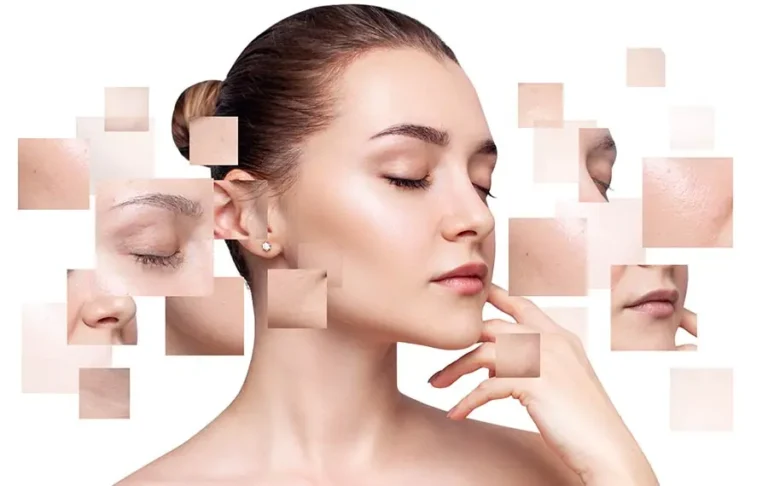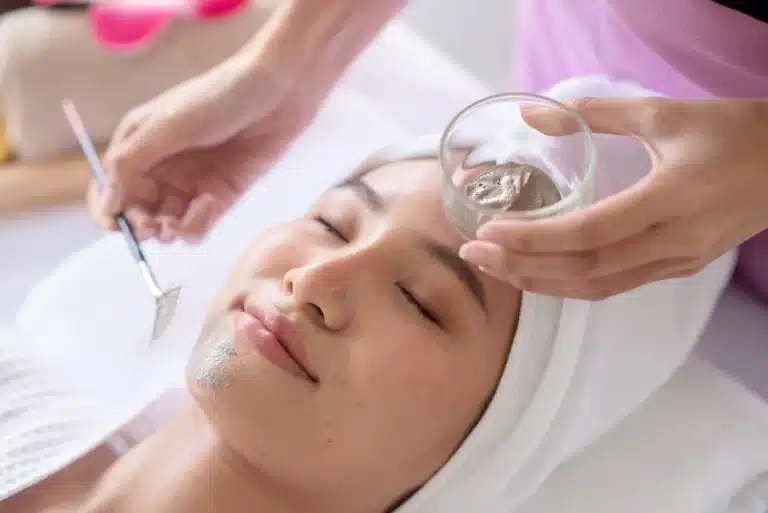Home » Conditions » Skin & hair » pigmentations
La pigmentation de la peau est un processus naturel déterminé par la mélanine, un pigment produit par des cellules appelées mélanocytes. La production de mélanine est influencée par divers facteurs. Des dysfonctionnements dans ce processus peuvent provoquer l’apparition de taches pigmentaires, qui peuvent être esthétiquement gênantes. En fait une peau lumineuse et homogène sans taches est une demande fréquente.
In most cases, skin pigmentation is of no consequence.
Néanmoins devant l’apparition de tâches brunes, il est indispensable de consulter un médecin pour avoir un diagnostic précis.
Apart from naevi (moles), pigmented lesions can be :
- Senile lentigos.
- Melasma.
- Freckles.
• Les taches d’hyperpigmentation : dues à une activité accrue des mélanocytes suite à une stimulation (traumatisme, bouton, acte médical, application d’agents chimiques…).
- Spots secondary to a fungal infection.
Les taches de la peau, qu’il s’agisse de taches brunes, de mélasma, de lentigos solaires ou d’hyperpigmentation, sont une problématique esthétique fréquente qui affecte la clarté et l’uniformité du teint. En médecine esthétique, plusieurs traitements existent pour corriger ces
imperfections cutanées et retrouver une peau lisse et éclatante. Le laser pigmentaire, les peelings chimiques et les traitements dépigmentants, permettent de réduire efficacement les taches pigmentaires pour avoir un teint uniforme.

La tache est la conséquence d’une production accrue ou anarchique de mélanine par les mélanocytes.
Melanin is the pigment that gives colour to the skin, and melanocytes are the cells responsible for its synthesis.
Les problèmes de pigmentation sont causés par des facteurs qui influencent cette production.
- Exposure to the sun: UV rays stimulate the production of melanin, which is why we tan, but excessive production of this pigment causes persistent spots.
- Hormones: hormonal changes, particularly during pregnancy or when taking contraceptives, play an important role in the appearance of melasma.
• Vieillissement : avec l’âge, le renouvellement cellulaire ralentit et l’activité des mélanocytes s’altère.
- Genetic factors.
- Inflammation of the skin: infections, acne, skin aggressions and even certain beauty treatments can cause local inflammation, leading to pigmentation, known as post-inflammatory pigmentation.
Les principaux actifs dépigmentants utilisés en esthétique et dans les crèmes sont :
• Hydroquinone : puissant inhibiteur de la production de mélanine, il est très efficace mais son usage est encadré pour éviter les risques d’irritation. Il se trouve dans les oignons, les fruits, les graines, le thé, le café, la bière et le vin. Son utilisation est consentie que dans des préparations magistrales comme le trio de Kligmann, son utilisation à ce jour est interdite dans les cosmétiques en vente libre.
• Arbutine : il s’agit d’un dérivé de l’hydroquinone qui se trouve dans les feuilles de cranberry et de blueberry.
- Kojic acid: derived from rice fermentation, it has natural lightening and antioxidant properties, acting gently on spots.
• Vitamine C : connue pour ses effets antioxydants, cet actif éclaircit les taches, stimule la production de collagène et offre un teint plus éclatant.
- Retinoids (vitamin A derivatives): promote cell renewal, exfoliate the skin's surface and reduce pigmentation spots.
- Azelaic acid: a gentle active ingredient, suitable for sensitive skin, which reduces hyperpigmentation and has anti-inflammatory properties.
• Acide tranexamique : agent dépigmentant efficace, idéal pour les peaux sujettes au mélasma, grâce à son action sur la pigmentation et l’inflammation.
• Acide phytique : il se trouve dans l’écorce des graines de céréales.
• Acide citrique : dérivé du citron.
• Niacinamide ou vitamine B3 : elle se trouve dans les racines des végétaux et dans les champignons.
Ces actifs sont souvent associés pour maximiser leur efficacité et apporter des solutions personnalisées pour un teint plus uniforme et lumineux.

To determine appropriate treatments, it is essential to distinguish the different types of pigment spots.
Les traitements esthétiques contre les taches sont des solutions efficaces pour les atténuer et unifier le teint. Selon le type de tache et le type de peau.
Laser and chemical peels are the most effective methods.
Il est important de comprendre que les traitements éliminent le pigment mais ne corrigent pas le dysfonctionnement des melanocytes. Les résultats sont donc transitoires, la pigmentation réapparaitra un ou plusieurs années après en fonction du mode de vie du patient, notamment de l’exposition solaire.

The depigmenting peel is an effective, non-invasive method for treating pigment spots and evening the skin tone.
Suited to pigmentation issues such as melasma, solar lentigos, and post-inflammatory pigmentation, this treatment is based on the application of powerful exfoliating agents such as glycolic acid, trichloroacetic acid, or kojic acid.
These substances eliminate the skin's superficial layers, encouraging cell renewal and visibly reducing spots.
The combination of these active ingredients yields visible results, with a clear improvement in skin uniformity in 84 % of cases after 2 treatments, a significant reduction (72 %) in melasma, and smoother skin with fewer fine lines after several sessions for 83 % of patients.
Sun exposure is contraindicated for two months. Peels cannot be performed on tanned skin.
The choice of laser will depend on the type of stain and the depth of pigmentation.
Two types of laser can be used:
- Laser depigmentation.
- The ablative laser.
Le mécanisme d’action des lasers dépigmentants est l’emploi d’un faisceau de lumière dont le temps de tir est très court, de l’ordre de la nonoseconde, ce qui permet de fragmenter le pigment.
En fonction de la profondeur du pigment on utilise un laser KTP Qswitched (pigment épidermique) ou Nd :Yag Qswitched (pigment dermique).
A small crust may appear on the treated area, and the patient should take care to grease it daily. One or more sessions may be necessary.
Doctor Romano prefers to use the ablative laser. Its mechanism of action is pigment vaporization. This treatment is more complex to perform but can treat all types of pigmentation (depigmenting lasers are not suitable, for example, for treating melasma). ablative laser does not cause post-inflammatory pigmentation.
In fact, although used to remove spots, depigmenting lasers can trigger local inflammation that worsens pigmentation.
It is possible to effectively prevent the appearance of pigment spots and maintain the skin’s natural radiance by adopting certain daily habits :
• Use daily sun protection : apply broad-spectrum sunscreen (minimum SPF 30) every day, even on cloudy days. This protects the skin from UV rays, the primary cause of pigmentation spots.
• Choose antioxidant-rich skincare : creams and serums containing vitamin C, vitamin E, or ferulic acid help neutralize free radicals that damage the skin and stimulate melanin production.
• Keep the skin well hydrated : proper hydration is essential for maintaining a healthy skin barrier, reducing inflammation and the risk of post-inflammatory pigmentation.
• Limit sun exposure : reduce time spent in the sun, especially between 10 a.m. and 4 p.m., and wear wide-brimmed hats and protective clothing to reduce the risk of brown spots.
• Use gentle skincare : avoid harsh products or treatments, as repeated inflammation or irritation can lead to post-inflammatory pigmentation.
• Use brightening ingredients preventively : ingredients such as vitamin C or azelaic acid help prevent melanin imbalance, even out the skin tone and reduce early pigmentation.
À Genève, les traitements médicaux destinés à atténuer les taches pigmentaires sont proposés à partir de 300 CHF la séance. Cette base tarifaire s’applique quelle que soit la méthode utilisée, qu’il s’agisse d’un laser ou d’un peeling. Le choix de la technique dépend de la profondeur et de l’origine des pigmentations. Le coût par session peut varier en fonction de l’étendue des zones à traiter et de la réponse cutanée observée.
Un devis est établi lors de la première consultation au cours de laquelle le docteur Romano annonce les résultats possibles, le coût de chaque séance et le nombre de séances nécessaires.
Il est impossible de faire disparaître les taches pigmentaires en seulement 3 jours de manière naturelle. Cependant, certains soins peuvent les atténuer : masque au citron (riche en vitamine C) pour éclaircir la peau, à appliquer avec précaution (et jamais avant une exposition solaire) ; gel d’aloe vera pour apaiser et régénérer la peau ; masques au miel et curcuma, aux propriétés éclaircissantes.
However, these methods offer gradual results and require regular use.
La majorité des taches pigmentaires, comme les lentigos solaires ou les taches de vieillesse, sont bénignes et sans danger. Toutefois, si une tache change rapidement de forme, de taille ou de couleur, il est recommandé de consulter un dermatologue pour écarter toute lésion précancéreuse.
Les principaux facteurs sont : l’exposition excessive au soleil sans protection ; les changements hormonaux (grossesse, contraception) ; certains médicaments photosensibilisants ; le vieillissement naturel de la peau ; le manque de soins adaptés, comme l’absence de protection solaire.
Oui, les taches pigmentaires peuvent réapparaître, surtout si la protection solaire n’est pas rigoureuse. Après un traitement, comme un peeling ou un laser, il est essentiel d’adopter une routine de soins adaptée et de limiter l’exposition au soleil pour prévenir la récidive.
Common pigmentation spots, such as solar lentigines, are benign and do not turn into cancer. However, regular monitoring is essential, as some precancerous skin lesions can resemble spots. In case of doubt, a dermatological consultation is recommended.
Les taches pigmentaires sont des dépôts de mélanine, souvent plates et liées au soleil ou à l’âge. Les grains de beauté (ou nævus) sont des amas de cellules pigmentaires qui peuvent être plats ou en relief, de couleur uniforme, et apparaissent dès l’enfance ou à l’adolescence. Tout changement suspect d’un grain de beauté nécessite un avis médical.